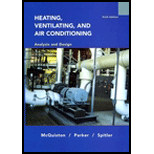
Concept explainers
A wall exactly like the one described in Table construction 1, has dimensions of
Trending nowThis is a popular solution!

Chapter 5 Solutions
Heating Ventilating and Air Conditioning: Analysis and Design
Additional Engineering Textbook Solutions
Automotive Technology: Principles, Diagnosis, And Service (6th Edition) (halderman Automotive Series)
Engineering Mechanics: Statics
Fluid Mechanics Fundamentals And Applications
Introduction To Finite Element Analysis And Design
Statics and Mechanics of Materials (5th Edition)
DESIGN OF MACHINERY
- 1.41 A heat exchanger wall consists of a copper plate 2 cm thick. The heat transfer coefficients on the two sides of the plate are 2700 and , corresponding to fluid temperatures of 92 and 32°C, respectively. Assuming that the thermal conductivity of the wall is , (a) compute the surface temperatures in °C and (b) calculate the heat flux in .arrow_forwardRepeat Problem 1.35 but assume that instead of surface temperatures, the given temperatures are those of the air on the left and right sides of the wall and that the convection heat transfer coefficients on the left and right surfaces are 6 and 10W/m2K, respectively.arrow_forwardWhat is the analogical reason between heat transfer by conduction and flow of electricity through ohmic resistance? Use a composite wall of a building to illustrate the concept. A composite slab with three layers of thermal conductivities k1, k2, k3 and thickness ti, t2, të respectively, are placed in a close contact. Derive an expression from the first principle for the heat flow through the composite slab per unit surface area in terms of the overall temperature difference across the slab.arrow_forward
- Calculate the heat flow per square meter (heat flux) through mineral wool insulation, U 5 cm thick, if the temperatures on the two surfaces are 30 and 200 °C, respectively.arrow_forward* Runner blanket = space blanket Thin square shape material : Mylar Weight : 0.2 lbs (85g) 32 layers are thickness 0.45mm (c) assume the inside surface temperature is 35oC and the outside surface is 15oC, calculate the heat loss rate in W/m2 through the blanket. Look up thermal conductivity values for the materialsarrow_forwardThe cooling load for a house is determined in part by using the same formulaused to find the heat load. The temperature difference used in designing acooling system is 25°F. The corner room shown does not face the sun so noadditional cooling load is required. The windows are single pane, and thewalls are brick veneer with 31⁄2 inches of insulation (R-11). The ceiling has31⁄2 inches of insulation (R-11), and the floor has no insulation. The room isbuilt over a vented crawl space with a vented attic above it. Find the coolingload for this room.arrow_forward
- Calculate the heat transfer rate for the following composite wall configurations:(A)Consider a composite plane wall that includes a 10 mm-thick hardwood siding, 50-mm by 120-mm hardwood studs on 0.7m centres with glass fiber insulation (paper faced, 28 kg/m3), and a 15 mm layer of gypsum wall board. What is the thermal resistance per unit area associated with thiswall (having 10 studs, each 2.5 m high). In addition, given the temperature at the inlet and outlet surface is 20 ºC and -15 ºC, calculate the heat transfer rate though this wall. (B) Stainless steel tube is used to transport pharmaceutical liquids, it has an inner diameter of 40 mm and a wall thickness of 4 mm. The pharmaceutical and ambient air are at temperatures of 6 C and 23C, respectively, while the corresponding inner and outer convection coefficients are 400 W/m2.K and 6 W/m2 K, respectively.(a) What is the heat gain per unit length?(b) What is the heat gain per unit length if a 10 mm thickness layer of calcium…arrow_forwardA thick walled tube of stainless steel with 20 mm inner diameter and 40 mm outer diameter is convered with a 30 mm layer of asbestos insulation (k = 0.2 W/m°C). If the inside wall temperature of the pipe is maintained at 600°C and the outside insulation at 1000°C, calculate the heat loss per metre of length.arrow_forwardConsider two aluminum (k=180 W/mK) pin-fin heat sinks with 1 mm and 2 mm square pins both 25 mm long. Assume that the gap between the pins = side of the pin, ie the one mm pin-fin heat sink has 1 mm gap between its pins. Assuming the module base is 50 mm x 50 mm and the heat sink cannot overhang due to lack of space, and h = 40 W/m?K with jet impingement, calculate: (a) Cooling surface area ratio (1 mm heat sink/ 2 mm heat sink) (b) Heat transfer ratio (1 mm heat sink/2 mm heat sink) Try to fit the maximum number of pins on the 50 mm x 50 mm base.arrow_forward
 Principles of Heat Transfer (Activate Learning wi...Mechanical EngineeringISBN:9781305387102Author:Kreith, Frank; Manglik, Raj M.Publisher:Cengage Learning
Principles of Heat Transfer (Activate Learning wi...Mechanical EngineeringISBN:9781305387102Author:Kreith, Frank; Manglik, Raj M.Publisher:Cengage Learning
